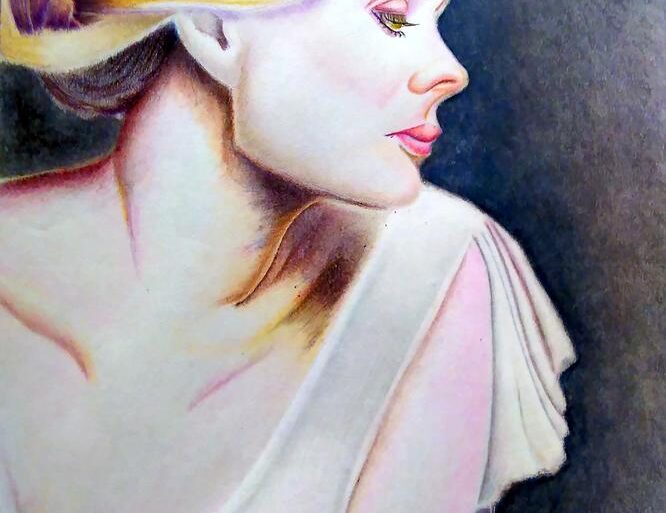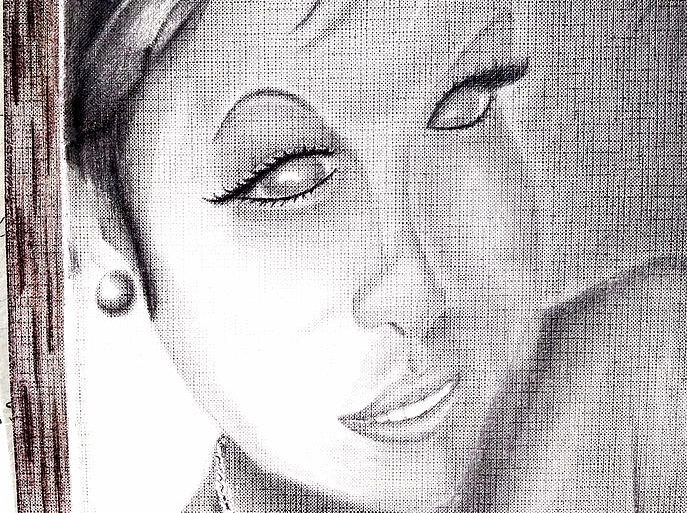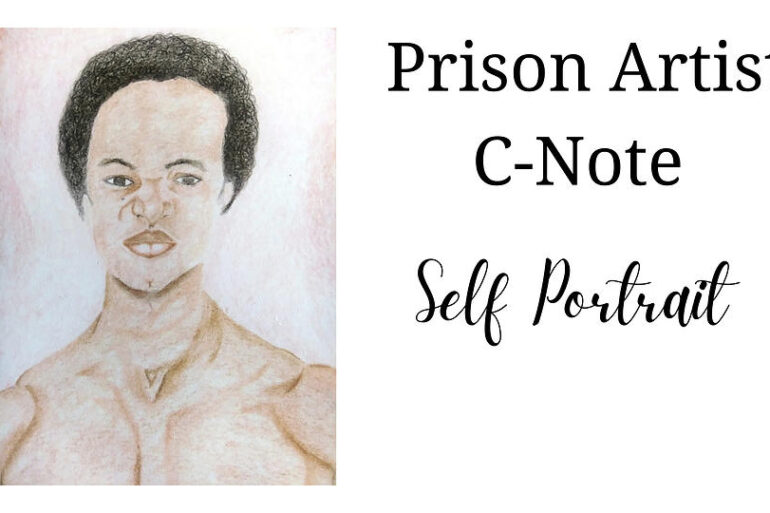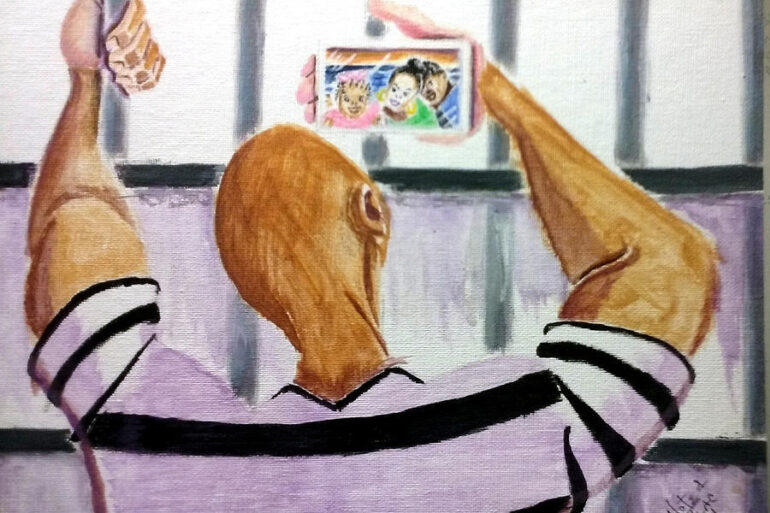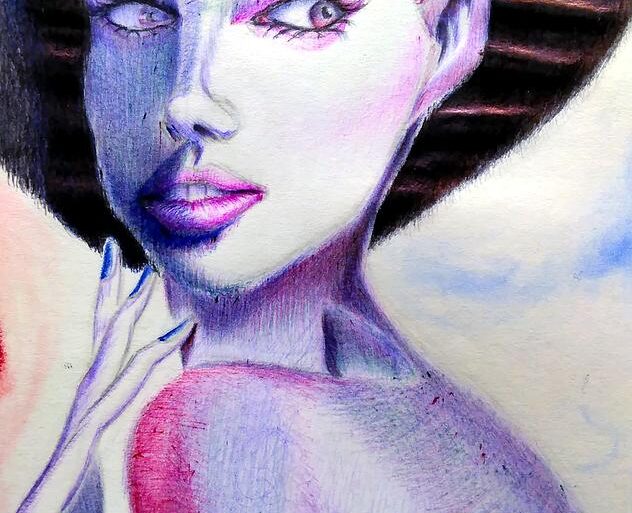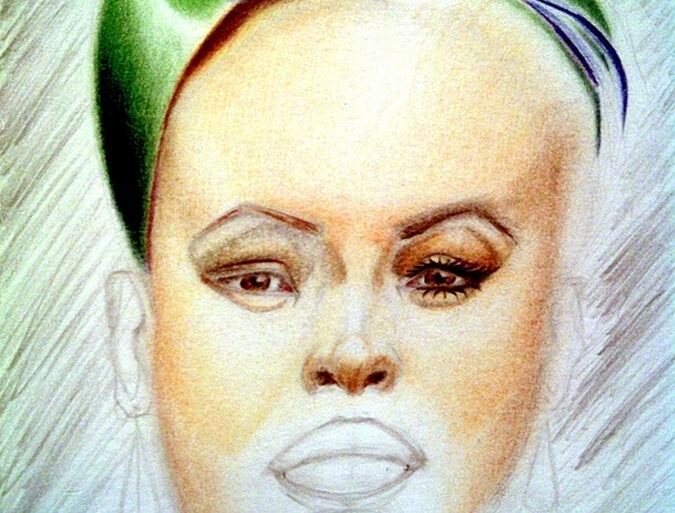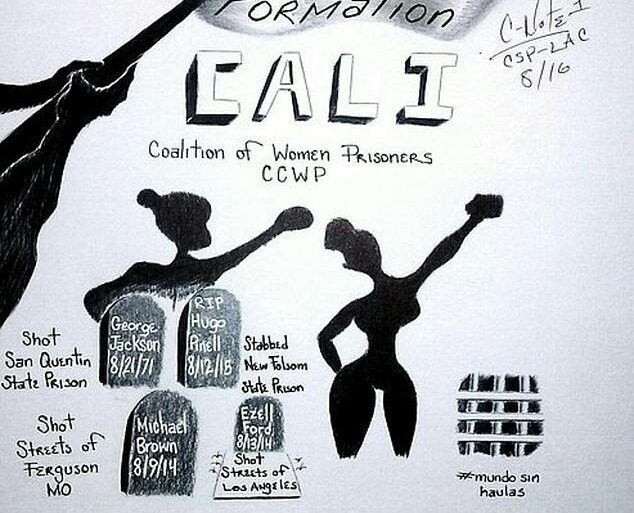Description
EXCERPTS FROM ARTIST INTERVIEW:DRPA: So what’s the next piece you have for us?C-Note: DianaDRPA: Very beautiful, now what is the story behind that?C-Note: This is “Colored Girl,” Part II, or the sequel. “Colored Girl,” was done in 2009, in 2016, I did “Diana.” The impetus is that I’m starting to be in galleries and museums. Probably patronized by white people, with 50% of the population being women, probably women, and older women. Who sees their beauty? I’ll never forget a conversation I saw on the CBS Morning Show with Charlie Rose, Norah O’Donnell, and Gayle King. Nora, was complaining about being dog whistled, or cat whistled at by men. Gail had a different take. She did not find that behavior offensive at all, in fact, wish guys would do that to her. So that set off an epiphany. I mean who’s cat whistling the grandmothers? Because that’s what Gayle King is. You read sex for people in their eighties is still wanted and desired. So we don’t stop being sexual and wanted because of our age. America is much criticized for being a youth culture; so I like to buck against the norms, root for underdogs. “Diana,” was created for the white, mature, woman, who may patronize the galleries and museums that my work may be in. It is my conversation with that audience, with that patronage, that “I” see you. That “I” see the beauty in you, and that I pay homage to that beauty. The piece was originally to be called “Diana A Roman Goddess,” but a friend of mine in here, who is dating a wiccan, she knew Diana to be a goddess. I had added the Roman Goddess part because I was fearful if I just use the name Diana it will be construed with “Princess Diana,” Lady Diana Spencer Princess of Wales (1961-1997), but since the Wiccans know Diana to be a goddess, simply Diana was the preferred titled.
Description
This "Untitled" painting was specifically created as the result of an artist Open Call by genArts for their Third Annual Experimental Exhibition. genArts is a program of SVCreates. Silicon Valley Creates (SVCreates) is dedicated to assembling, supporting, and empowering a thriving community of arts and culture leaders who are prepared to guide and serve the region’s arts and culture community of tomorrow.Focused locally on San Jose and Silicon Valley as a whole, SVCreates still maintains important statewide connections across California and keeps an eye on the national conversations in the arts and culture sector, specifically through their connection to American for the Arts as a registered Local Emerging Leaders Network.This exhibition would feature artwork from 25+ Santa Clara County artists, capturing their voices, identities, and essences. Accepted artwork would be displayed at Crema Coffee, 1202 The Alameda, San Jose, CA 9512 from August 12 through September 28C-Note, who is a California prisoner, and does not reside in Santa Clara County, is represented by art broker Anna D. Smith, who is located in San Jose, CA. As a result of Smith's representation, she curated two billboard art installations during the pandemic, both times were solo features of artwork by prison artist C-Note, "Incarceration Nation," and "Colored Girl Warholed." C-Note and this "Untitled" work was not accepted into the exhibition.The acrylic painting was painted on a 9 in. x 12 in. canvas board. The main subject was inspired by an editorial fashion photo in a fashion. The coffee next to the plant pot, in honor of the location of the exhibition, Crema Coffee.
Description
October 20th - 23rd 2021, was the 13th Annual International Prisoner's Family Conference. This year's conference was virtual. Topics included civil rights don't end at the prison gates, prison reentry, children of incarcerated parents, prison wives, and other topics. It also included a Facebook art auction of Prison art. C-Note donated a work to the conference that was specifically created for the event.Man in the Mirror, 2021, 9 in. x 12 in., Acrylic on canvas, Donald "C-Note" Hooker, features a prisoner looking at himself with a handheld mirror. What the mirror reflects back, it's not his image, but an image of him, his wife and child.
Description
According to the Associated Press (AP) headline in 1998, "Calif. Prisons To Remove Weights," the AP wrote, "In a reversal of a trend dating to the 1960s, California prisons are moving to eliminate privileges such as access to weight-training equipment and tighten up appearance standards.Plans are also in the works to remove law books inmates use to challenge their confinement.``We got into the position at one juncture of providing a rather comfortable lifestyle in prison,″ said Sean Walsh, Gov. Pete Wilson’s spokesman. ``We should not allow prisoners to ride roughshod over the prisons.″The moves come as officials issue warnings about crowding in California’s 33 prisons, and as prisoners and their advocates say a tense atmosphere behind the walls is getting worse.In addition, the changes are attracting the approval of some legislators as Wilson renews his call for the Legislature to approve $1.4 billion in bonds to help finance four new prisons.One month ago, officials began enforcing new grooming standards that require men’s hair to be closely cropped, a measure that prompted at least 100 inmates at Folsom Prison to stage a hunger strike on New Year’s Day. The removal of weight-lifting gear is expected soon.``It’s all part of a comprehensive review of prison operations,″ said Tom Maddock, head of the Youth and Adult Correctional Agency. ``The core reasons are safety, security and taxpayer efficiency.″Among other steps planned this year, Maddock said prison officials plan random drug tests for inmates and will prohibit packages from being sent directly to inmates. That move is aimed at reducing drug use.A program is also afoot to require all inmates to wear white jumpsuits, instead of blue jeans and blue work shirts, thus making it more difficult for escapees to blend in, officials say.Prisoners’ rights advocates, inmates and relatives long have criticized the Department of Corrections for what they consider its punitive approach, but these latest changes are drawing criticism from within the system.``We’re going to drag them out of their drums cells and shave their heads?″ asked Don Novey, president of the California Correctional Peace Officers Association, the guards union. ``The irony of it. You’re massively overcrowded. You’re understaffed. ... It’s stupid. But it resonates with the public. We get this perception that we’re tough with the pedophiles.″Lawyers representing prisoners and other advocates are trying to block the moves, and Sen. John Vasconcellos, D-San Jose, plans to hold a hearing on the proposals.But many other legislators support the changes, and the department has broad authority to invoke emergency powers to change its rules.Matthew Jay, 30, serving 15 years to life at Solano State Prison for second-degree murder, is one of thousands of prisoners whose home is a bunk in a prison gym. Lifting weights is one of the few pastimes that relieves frustration, he said; without them tensions will rise.But he’s more worried about the potential loss of law books.``If that access is taken away, we are no longer in a prison. We are in a war camp, like a prisoner of war,″ Jay said. ``When rights are violated, we’re left with no alternative but to react. We want to prevent that.″The trend toward greater prisoners’ rights began in the 1960s, when inmates gained expanded privileges and prison officials placed more emphasis on rehabilitation.Gov. Ronald Reagan signed the single-paragraph Inmates Bill of Rights into law in 1968 and Gov. Edmund G. ``Jerry″ Brown Jr. expanded it in 1974, stating that prisoners retained all rights except those that had to be denied in order to protect prison security and public safety.By the 1990s, however, lawmakers took a different approach. The Legislature passed new sentencing laws and watered down the Inmates Bill of Rights. The statute now limits inmates’ rights generally to those required by the more restrictive federal laws.California prisons had been under a 1972 federal court order to maintain full law libraries. Citing a 1996 U.S. Supreme Court decision allowing prisons to limit law libraries, the state Department of Corrections persuaded U.S. District Judge Susan Illston in San Francisco to lift the 1972 injunction, opening the way for the department to remove most law books."According to the California Legislative Analyst's Office, "As of January 31, 2000 state prisons were at about 195 percent of their design capacity." This severe overcrowding would lead to a 2011 decision by a conservative US Supreme Court to order California to release 30,000 prisoners, because of its extreme overcrowding had horrible consequences, including deaths, in violation of the 8th Amendment to the US Constitution's Cruel and Unusual Punishment Clause. See Brown v. Platt. It was during this era of California prisoner #K94063, Donald "C-Note" Hooker's young Three Strikes sentence in 1998, that on January 1, 2000, he and other African Americans found themselves in solitary confinement after a riot with prison guards, at a prison the AP would later report on in a 2015 headline "Report: Alarming abuses seen at remote California prison," and the Washington Times headlined, "State report finds ‘culture of racism,’ alarming abuses at remote Northern California prison."These reports were based on a California Inspector General finding. It was at this time, C-Note decided to take up picture drawing, as opposed to continuing on as a poet and writer of Rap lyrics. Included in this era from 1998, during the whole of the 2000s saw the banning of prisoners being allowed to take photos at yard time. The new rules permitted only prisoners who received a visit could take photos, breaking with a long tradition of allowing prisoners to take photos of themselves and with others.Since most prisoners did not receive visits, especially at a remote prison as C-Note was from 1998 - 2011, High Desert State Prison (HDSP), he had to draw a self portrait of himself, so that the people he was newly meeting through correspondence had an idea, what he looked like.
Prison Artist C-Note Self Portrait by Donald C-Note Hooker
Description
October 20th - 23rd 2021, was the 13th Annual International Prisoner's Family Conference. This year's conference was virtual. Topics included civil rights don't end at the prison gates, prison reentry, children of incarcerated parents, prison wives, and other topics. It also included a Facebook art auction of Prison art. C-Note donated a work to the conference that was specifically created for the event.Man in the Mirror, 2021, 9 in. x 12 in., Acrylic on canvas, Donald "C-Note" Hooker, features a prisoner looking at himself with a handheld mirror. What the mirror reflects back, it's not his image, but an image of him, his wife and child.
Description
Adriana W. (2016)5.5 in. x 8.5 in. (14 x 21.6 cm)Blue, red, green, purple, pink, and black ink pen on paperDonald "C-Note" HookerThe actress and the journalist should be the title of this piece by the world's most prolific prisoner-artist, Donald "C-Note" Hooker. Instead, it's the backstory. "Adrian W.," is a work that was inspired by a famous actress who was involved in a Madison Avenue ad campaign for a well known perfume. The model for this piece came from a magazine picture of a famous actress, and then named after a news reporter who interviewed the artist."It was a very challenging piece," says C-note. "How does someone create likeness without using flesh colors? If this was done monochromatically in graphite or black ink there's no problem. I love this piece. I think I did a good job considering this was a one take piece. The color scheme and placement was all done on the fly."
Description
Adriana W. (2016)5.5 in. x 8.5 in. (14 x 21.6 cm)Blue, red, green, purple, pink, and black ink pen on paperDonald "C-Note" HookerThe actress and the journalist should be the title of this piece by the world's most prolific prisoner-artist, Donald "C-Note" Hooker. Instead, it's the backstory. "Adrian W.," is a work that was inspired by a famous actress who was involved in a Madison Avenue ad campaign for a well known perfume. The model for this piece came from a magazine picture of a famous actress, and then named after a news reporter who interviewed the artist."It was a very challenging piece," says C-note. "How does someone create likeness without using flesh colors? If this was done monochromatically in graphite or black ink there's no problem. I love this piece. I think I did a good job considering this was a one take piece. The color scheme and placement was all done on the fly."
Description
Black August-Los Angeles,” is an original work of ink on paper done in 2016 by the world's most prolific prisoner-artist, Donald "C-Note" Hooker. This piece was inspired by the month long Black August , celebrations that were taking place in Los Angeles, in 2016. He first heard of these celebrations on Think Outside the Cage. This was this artist first attempt at Political Art. It makes reference to Beyonce’s “Formation;” the death of prisoners, and prison reform activists, George Jackson, and Hugo “Yogi” Pinell. Both men were murdered in prison. Police shooting death victims, Michael Brown, and Ezell Ford. These kind of deaths have reawakened America’s consciousness on it’s criminal justice system, thus prison reform. The California Coalition of Women Prisoners (CCWP), so that the public doesn’t forget we imprison women too. The Los Angeles Women’s Center, to bring public consciousness, and hopefully funding, to a place that provides services and refuge to women, most likely from the same environmental milieu as those who have been, or will become imprisoned. The Raised Fist, a symbol of Black Power during the Civil Rights Movement of the 1960’s. Now a symbol of empowerment during any struggle. And “Mundo Sin Jaulas” (A World Without Cages), in recognition of the Brown People’s Movement.Black August - Los Angeles is listed in Wikimedia Commons's extensive Library as one of only 12 artworks in it's Black Cultural Archives.
Description
Black August - Los Angeles,” is an original work of ink on paper done in 2016 by the world's most prolific prisoner-artist, Donald "C-Note" Hooker. This piece was inspired by the month long Black August , celebrations that were taking place in Los Angeles, in 2016. He first heard of these celebrations on Think Outside the Cage. This was this artist first attempt at Political Art. It makes reference to Beyonce’s “Formation;” the death of prisoners, and prison reform activists, George Jackson, and Hugo “Yogi” Pinell. Both men were murdered in prison. Police shooting death victims, Michael Brown, and Ezell Ford. These kind of deaths have reawakened America’s consciousness on it’s criminal justice system, thus prison reform. The California Coalition of Women Prisoners (CCWP), so that the public doesn’t forget we imprison women too. The Los Angeles Women’s Center, to bring public consciousness, and hopefully funding, to a place that provides services and refuge to women, most likely from the same environmental milieu as those who have been, or will become imprisoned. The Raised Fist, a symbol of Black Power during the Civil Rights Movement of the 1960’s. Now a symbol of empowerment during any struggle. And “Mundo Sin Jaulas” (A World Without Cages), in recognition of the Brown People’s Movement.

